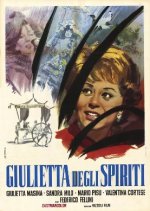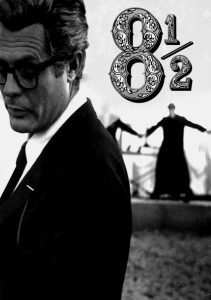Juliet Of The Spirits-1965
Director Federico Fellini
Starring Giulietta Masina, Sandra Milo
Top 250 Films #188
Scott’s Review #725
Reviewed February 15, 2018
Grade: A
A true Fellini film in every sense and perhaps his most personal film, 1965’s Juliet of the Spirits, is a colorful and masterful experience with fluid art direction and stunning sets and costumes.
As with most of his films, the story and its intricacies are odd and do not always make perfect sense, but the film is meant to be absorbed and felt and exhibits more of a central plot than some of his other works.
Juliet of the Spirits is undoubtedly a must-see for fans of Fellini or any novice who wants an introduction to the great director.
In a compelling tidbit of background information, lead actress Giulietta Masina, wife and muse of director Fellini and sometimes deemed the female Charlie Chaplin, plays a true-to-life character.
In real life, the woman suffered from a philandering husband- Fellini himself!
For this reason alone, the film is fascinating as a true-to-life story, leading the audience to empathize with Giulietta and her life of doldrums and turmoil.
Giulietta Boldrini (Masina) is an affluent woman living in Italy with her successful and dashing husband, Giorgio (Mario Pisu). Despite wealth, two housekeepers, and free time to do whatever she pleases, she is dissatisfied with her life and surroundings.
This occurs mainly after she hears her husband mutter another woman’s name in his sleep. Concerned and intrigued, Giulietta hires investigators to unravel the mystery, which spawns an adventure for her.
Instead of being a cookie-cutter film with a basic plot explained above, in proper Fellini form, the character of Giulietta embarks on a journey into the dreamlike and odd experience, tapping into her repressed desires and innermost thoughts while being exposed to her larger-than-life and sexy neighbor, Suzy (Sandra Milo).
The oversexed Suzy enlightens Giulietta to the joys of her mansion, treehouse, dazzling, weird friends, and bubbling sensuality.
Juliet of the Spirits is a joy to watch and quite a bit more linear than other complex masterpieces, such as the 1960s La Dolce Vita or 1969’s Fellini Satyricon.
The plot is spelled out presently- Giulietta is depressed and anxious for something new and exciting. Her journey into this new life, marked by her wrestling with demons and resistance, makes this film so much fun.
Styles and colors are brilliant and lavishly loud. Take the gaudy and glamorous nest that Suzy calls home. Her palace is both tawdry and sophisticated, with a built-in underground swimming pool where she bathes after lovemaking and velvety red walls and furniture.
Fellini uses gorgeous reds, greens, and blues throughout the film to create dazzle and spectacles with larger-than-life characters.
To further focus on Suzy for a minute, the blonde bombshell frequently visits her very own treehouse, complete with a swing. She flirts with handsome young men who gaze up at the scantily dressed beauty as she tosses her high-heeled shoe down to them in a suggestive manner.
When they come up to the top of the treehouse by way of a mechanical basket, presumably for sex, this is too much for the overwhelmed Giulietta, who returns to the safety of her own home.
But she is excited and scared.
The film belongs to Masina, and we cannot help but wonder if Fellini created Juliet of the Spirits for the actress because of his reported years of cheating. Regardless, Masina plays a confident woman on the outside- insecure on the inside, flawlessly.
With her expressive eyes and a nice smile, Masina enthusiastically embraces the role, making her a perfect fit for a Fellini film.
Juliet of the Spirits mixes several film genres, including fantasy, drama, and light comedy, and contains interesting supporting characters.
Suzy’s seemingly clairvoyant mother is a great side character. Upon meeting Giulietta, she immediately sees that the woman is troubled. Giulietta’s father, whom we meet when she is a little girl appearing in a religious play, is boisterous and spirited.
I was fortunate enough to stay at the Grand Hotel in Rome, a lavish yet strange establishment where Fellini spent many nights as a guest. While watching Juliet of the Spirits, I fantasized that he drew inspiration for this film from the hotel.
The grand red textures, which appear in both the hotel and the Fellini film, could have created a truly inspiring facility.
Stalwart, creative, and masterful director Fellini once again crafts a stylish film that warrants thoughtful consideration after a solid viewing.
Too much analysis, however, will ruin the enchanting experience. Juliet of the Spirits (1965) is best enjoyed as a treat that will mesmerize you in glamorous fashion.
Oscar Nominations: Best Art Direction, Color, Best Costume Design, Color

